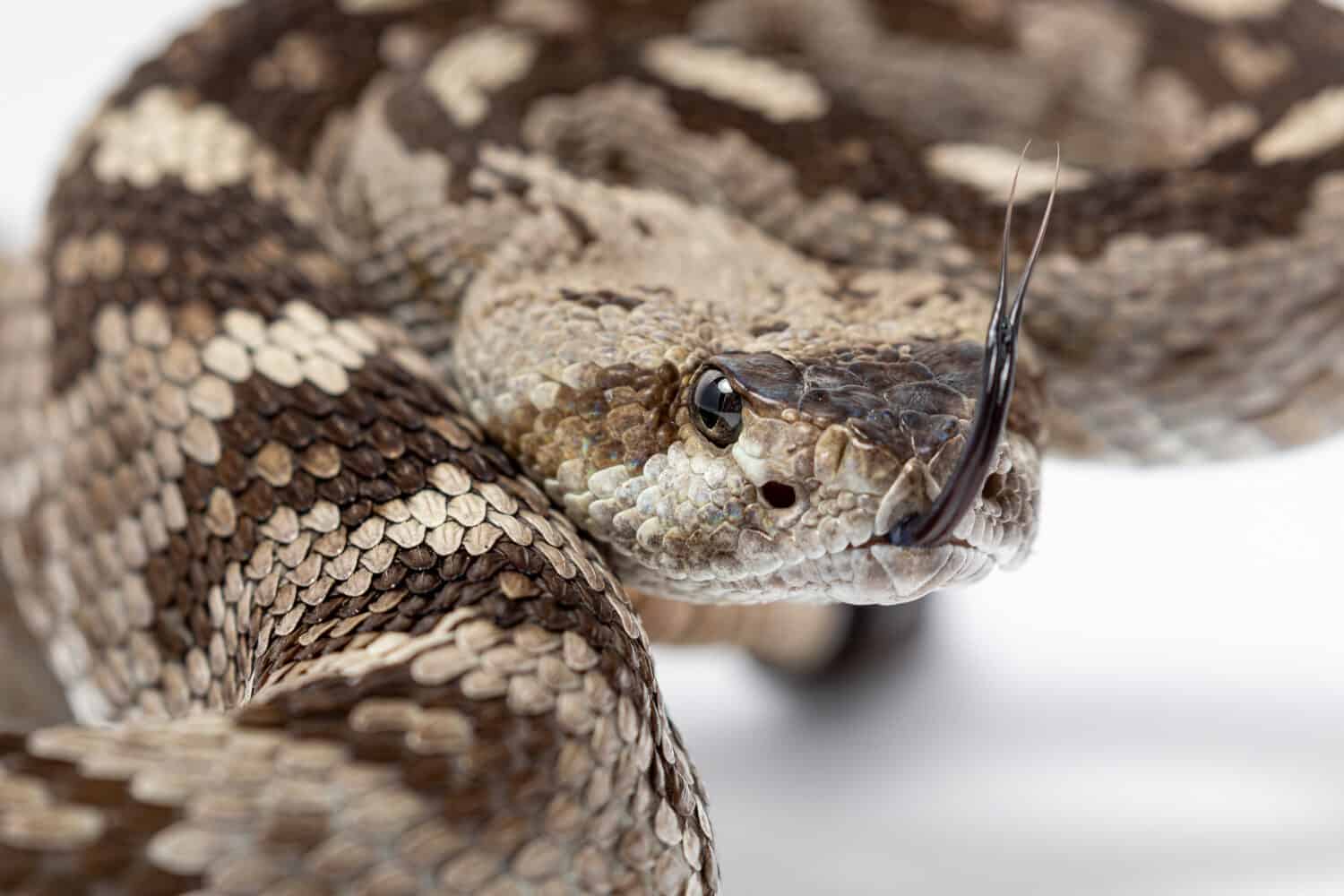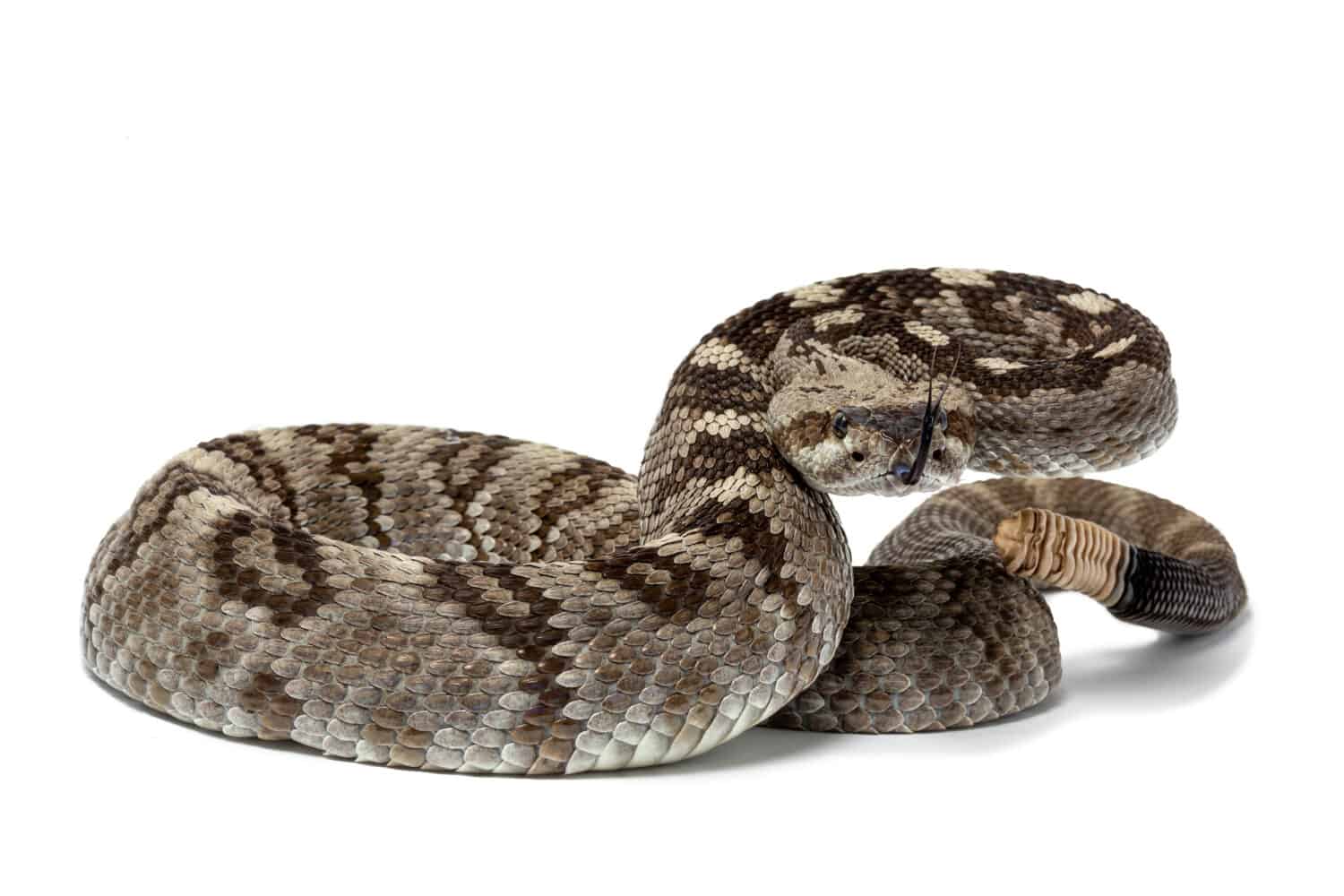Ornate Black-Tailed Rattlesnake
ornatus
Ornate black-tailed rattlesnake mothers stay with their newborn babies for up to a month.
Advertisement
Ornate Black-Tailed Rattlesnake Scientific Classification
- Kingdom
- Animalia
- Phylum
- Chordata
- Class
- Reptilia
- Order
- Squamata
- Family
- Viperidae
- Genus
- Crotalus
- Scientific Name
- ornatus
Read our Complete Guide to Classification of Animals.
Ornate Black-Tailed Rattlesnake Conservation Status
Ornate Black-Tailed Rattlesnake Facts
- Prey
- Rats, mice, small rabbits, baby birds, lizards, insects
- Main Prey
- Rodents
- Name Of Young
- Neonates, snakelets
- Group Behavior
- Mainly solitary
- Communal Dens
- Fun Fact
- Ornate black-tailed rattlesnake mothers stay with their newborn babies for up to a month.
- Estimated Population Size
- Unknown
- Biggest Threat
- Habitat loss
- Other Name(s)
- Ornate blacktail, ornate blacktail rattlesnake, ornate black-tailed rattlesnake, eastern black-tailed rattlesnake
- Gestation Period
- 90 days
- Litter Size
- 1-15
- Lifestyle
- Nocturnal
- Diurnal
- Crepuscular
Ornate Black-Tailed Rattlesnake Physical Characteristics
- Color
- Brown
- Grey
- Black
- Green
- Dark Brown
- Dull Olive
- Black-Brown
- Olive-Grey
- Grey-Brown
- Skin Type
- Scales
- Lifespan
- 15-20 years
- Length
- Up to 3 1/2 feet
- Age of Sexual Maturity
- 2-3 years
- Venomous
- Yes
- Aggression
- Low
View all of the Ornate Black-Tailed Rattlesnake images!
Ornate black-tailed rattlesnakes are among the most beautiful snakes in the Americas.
These mild-mannered snakes usually slither away before giving away their position by rattling. But be careful not to step on them because they can deliver a painful venomous bite.
Their lack of legs allow them to slither in and out of places off limits for other predators. Rattlesnakes are vital to the ecosystem and keep vermin from overrunning the world.
3 Ornate Black-Tailed Rattlesnake Amazing Facts
- Ornate black-tailed rattlesnakes give birth in the summer and sometimes protect their babies for a month after birth.
- Some call these calm snakes docile — but they’re still rattlesnakes!
- Until 2012, this species was counted as one of the black-tailed rattlesnake’s (Crotalus molossus)subspecies.
Ornate Black-Tailed Rattlesnake Scientific Name
Rattlesnakes are members of the Crotalinae subfamily of snakes. All pit vipers are in this subfamily and native to the Americas and parts of Asia and Indonesia.
With more ornate markings than their western black-tailed rattlesnake cousins, ornate black-tailed rattlesnakes get their common name from both their tail color and the markings. According to The Reptile Database, their scientific name became Crotalus ornatus in 2012 after phylogenetic testing showed they were genetically distinct from their western cousins. However, some sources still refer to them scientifically as Crotalus molossus ornatus.
Rattlesnake Evolution & Origins
These venomous snakes are more recently evolved and classified into the Crotalinae subfamily, also known as pit vipers. They likely evolved 25 to 45 million years after the vipers in the Viperidae family.
These highly evolved snakes have heat-sensing pits, hinged fangs, huge venom glands, and keratin-based rattles at the ends of their tails.
Researchers say that their rattles may have been part of a response to the bison that also roamed the plains where these snakes likely evolved. It’s possible that the rattling behavior was a way to rustle the leaf litter as a way to make noise, getting the animal to move away. Unfortunately, there’s no proof of how they evolved, but scientists have some ideas.
One idea is that the snakes that could rattle their tails the longest and loudest were better at deterring threats. So, they evolved a more sophisticated noise maker: the rattle.
Another idea is that the best rattlers developed keratin callouses on their tails. Over time, this could have caused genetic differences that allowed those to evolve into rattles.
Venom has an interesting story.
This part of nature’s arms race evolved in dozens of species at different times. In some cases, the animals evolved and lost their venom multiple times. Scientists don’t know why. However, the need for venom most likely disappeared for a while before reemerging.
The three main types of venom are neurotoxic, hemotoxic, and cytotoxic. Snakes use them to incapacitate or kill their prey. However, they also use it against predators and other threats.
The most common venom rattlesnakes possess is hemotoxic, but many rattlesnakes also have a percentage of cytotoxic or neurotoxic venom. The venom composition varies from one species to the next. Even different populations within the same species can have different concentrations of toxins.
Ornate Black-Tailed Rattlesnake Appearance and Description

Ornate black-tailed rattlesnakes have two large triangular intranasal scales. Image: Scott Delony, Shutterstock
©Scott Delony/Shutterstock.com
A medium-sized rattlesnake, ornate black-tailed rattlesnakes average between three and four and a half feet long. These snakes have broad, triangular heads on comparatively thin necks with thick bodies that end in keratin-based rattles, although newborn snakes only have a tail button.
These beautiful snakes have keeled scales and colors, including grays, olive greens, browns, and black. Over their base color are dark, roughly rhomboid markings with jagged edges and light centers. The first six to eight markings are almost always connected, and they become lighter toward the tail, which is solid black.
While snakes at higher altitudes often have darker overall coloration, ornate black-tailed rattlesnakes are easily identified. This is because they have a dark mask over their nose and eyes, similar to other black-tailed rattlesnake species. However, these snakes don’t have as much black on their heads; instead, they often have one-scale-wide ornate-looking lines.
Their eyes have vertical pupils and a large scale over their eyes. One difference between these and black-tailed rattlesnakes is that you’ll see two large triangular intranasal scales. These scales sit right on top of the snout.
Ornate Black-Tailed Rattlesnake Behavior

While they’re docile, ornate black-tailed rattlesnakes will coil into an ’S’ shape to warn away threats. Image: Scott Delony, Shutterstock
©Scott Delony/Shutterstock.com
Like all rattlesnakes, the ornate rattlesnake is shy. It has no interest in people other than avoiding us because we are about 200 times bigger.
Ornate black-tailed rattlesnakes’ color patterns are well-suited to their habitat. These snakes blend in and become nearly invisible, which is how most bites occur. Because they’re so calm, they often don’t rattle until it’s too late for either pets or people to avoid them.
These snakes hide in rocky crevices under scrub brush while waiting for a meal. They’re most active in the spring and fall when they travel to and from brumation sites. When the weather is most comfortable, you can find ornate black-tailed rattlesnakes active during the day, but on the summer’s hottest days, they switch to nocturnal habits.
During the winter, ornate black-tailed rattlesnakes settle into abandoned animal burrows, caves, and other secluded spots that shelter them from the coldest weather. They’re often found sharing space with other species peacefully until the spring, when they all go their separate ways.
Ornate Black-Tailed Rattlesnake Habitat
Although they prefer drier areas, ornate rattlesnakes are habitat generalists. They can inhabit open forests, mesquite grasslands, rocky areas, and dry riverbeds. Essentially, you may find one of these snakes anywhere there are enough hiding places and prey in their range.
Ornate Black-Tailed Rattlesnake Diet
Snakes like the ornate black-tailed rattlesnake are ambush predators. These stocky snakes aren’t agile hunters like kingsnakes, so they find a great hiding spot and wait — sometimes for days for a meal to wander close enough. They don’t actively hunt unless prey is sparse and they haven’t eaten recently.
Ornated black-tailed rattlesnakes eat various small animals like rats, mice, and small rabbits or hares. Juveniles also eat insects and lizards.
Venom: How Dangerous Is an Ornate Black-Tailed Rattlesnake?
Scientists rate this snake’s venom at about 80% as strong as a western diamondback rattlesnake. Ornate rattlesnakes are mellower than many other species but will bite if cornered. However, that doesn’t negate their danger.
Bites are rare, but because ornate rattlesnakes don’t rattle as early as others, the most dangerous way to encounter one is by stepping on or too close to it. Most bites occur on the hands and feet as people are hiking or climbing, so the best way to avoid getting bitten is by keeping your hands and feet within view.
First Aid for Rattlesnake Bites

Most bites occur when humans accidentally step on or near a rattlesnake or attempt to handle or kill one.
©Chuanpit/Shutterstock.com
An ornate black-tailed rattlesnake bite is a medical emergency. Although estimates place the percentage of dry bites as high as 40%, it’s best to head to the hospital.
This rattlesnake’s venom is primarily hemotoxic and damages the blood cells. It affects clotting activity and causes internal bleeding, swelling, and intense pain.
If a rattlesnake bites you, there are a few things you can do to help minimize damage before you get to the hospital. Of course, if you have a friend to drive you, that’s ideal!
- Get out of striking distance of the snake.
- Take a photo or otherwise document basic features.
- Remove tight-fitting clothing and jewelry.
- Immobilize and elevate the affected body part, but keep it below the level of your heart.
- Do not use tourniquets or ice.
- Don’t try to cut into the wound or suck the venom out.
Venom in Medicine
Pit viper venom has extensive medical uses. At last count, there are about 20 medicines derived from the proteins in different snake venoms. For example, venom from the golden lancehead has been used in medical research, and couple of heart medications exist as a result.
Here are a few types of medicines derived from venom:
- ACE inhibitors from South American pit viper venom.
- Type 2 Diabetes drugs from the Gila monster’s venom.
- Medications to stop uncontrolled bleeding from saw-scaled vipers and eastern brown snakes’ venom.
- Blood thinners from several vipers’ venom.
Ornate Black-Tailed Rattlesnake Reproduction, Babies, and Lifespan
Typically, ornate black-tailed rattlesnake females mate every two to three years in spring and give birth to up to 15 babies in the summer. This species is one of the more attentive snake parents, and females often spend up to a month protecting the young snakes before going off on their own again.
Ornate black-tailed rattlesnakes mature at around three years, sooner if their home range has a lot of prey. This species can live up to 20 years, possibly longer in captivity.
Ornate Black-Tailed Rattlesnake Population, Conservation Status, and Threats
The IUCN Redlist of Threatened Species has not assessed the ornate black-tailed rattlesnake. Since it’s a newer reclassification to full species status, there haven’t been any studies. However, if the information in the 2007 black-tailed rattlesnake holds, the ornate black-tailed rattlesnake population is likely stable.
Save the Buzztails, a non-profit organization based in Florida, sponsors education and studies to help people understand rattlesnakes’ importance to the ecosystem. Hopefully, with education, fewer snakes will be killed out of fear. However, this species often lives in remote areas where people aren’t as likely to encounter them.
Like other rattlesnakes, ornate rattlesnakes are preyed on by any number of larger animals. Everything from hawks and eagles to roadrunners, coyotes, and other predators will kill and eat them. Other, more dangerous threats are habitat loss and humans killing them out of fear.
Similar Animals
View all 66 animals that start with OOrnate Black-Tailed Rattlesnake FAQs (Frequently Asked Questions)
Where do ornate black-tailed rattlesnakes live?
These venomous reptiles live in New Mexico, Texas, and areas of Mexico.
Are ornate black-tailed rattlesnakes poisonous?
Not technically. Because these snakes inject toxins into victims, they’re considered venomous.
What’s the difference between venomous and poisonous?
It’s really easy to get this confused. Some languages don’t have separate words for the two, and until recently, all scientific literature referred to venomous snakes as poisonous.
Most scientists now refer to animals with fangs or spines that forcibly inject a toxic substance into victims as venomous. In contrast, they consider animals or plants where you ingest or absorb the toxin poisonous.
What do ornate black-tailed rattlesnakes eat?
Their favorite foods include rodents! Their diet includes rats, mice, small rabbits, baby birds, even lizards and insects.
Thank you for reading! Have some feedback for us? Contact the AZ Animals editorial team.
Sources
- The Reptile Database, Available here: https://reptile-database.reptarium.cz/species?genus=Crotalus&species=ornatus
- Save the Buzztails, Available here: https://www.savethebuzztails.org/species-accounts/Eastern-Black-Tailed-Rattlesnake
- IUCN Redlist of Threatened Species, Available here: https://www.iucnredlist.org/species/64324/12768461

















